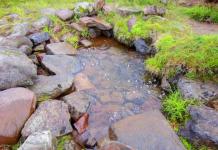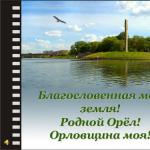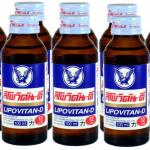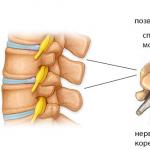



































 Back forward
Back forward
Attention! Slide previews are for informational purposes only and may not represent all the features of the presentation. If you are interested in this work, please download the full version.
Goals and objectives:
- Educational: introduce students to the facts of the history of the Oryol region, its tales and legends; introduce children to Oryol crafts.
- Developmental: develop creative imagination, fantasy, memory.
- Educational:
- to form a feeling of love for one’s small homeland, pride in one’s land.
- to cultivate aesthetic taste, to develop a perception of the beauty of folk crafts of the Oryol region.
Hello children. Today you will learn how rich and famous the Oryol region is, about its history, legends and traditions.
You will learn about what talents our fellow countrymen have.
If you take part in the quiz, you will be able to put together a map of the Oryol region from puzzles.
Organizing time
The lesson begins
Let all knowledge be used for future use.
All you need to do is not be lazy
And work hard.
Topic of our lesson: Blessed is my land! Dear Eagle!
My Orlovschina!
MUSIC - V. Kalinnikov Bylina - overture
Let's go to my land
In the fields, in the meadows of the Oryol region,
I have never seen a better place anywhere.
I'm on first name terms here
With any stream and grove,
Here for me
The beginning of all beginnings.
D. Blynsky
Blessed Oryol region! A page from the great chronicle of Russia, a piece of the history of the Fatherland.
What is our Oryol region famous for? First of all, its history.
MUSIC song "Glory to the gods and ancestors"
Let's lift the veil of time and look into the past. In ancient times, the Vyatichi Slavs lived on our lands. According to legend, they were called Vyatichi because an elder named Vyatko brought them to our free, generous land.
Chronicles were written briefly.
Can't guess in a tight line,
What was he like, our ancestor Vyatko,
When he settled on the Oka.
He probably walked around with a beard,
Her hair curled up to her shoulders.
On an autumn evening over the water
He loved to burn a high fire.
I believe in his goodness and strength.
He stood up with the birds.
I went to war only against the beast,
And he invited the man to visit.
V. Katanov
The Oryol land is the land of legends and tales, the heroes of which were Russian heroes. They say that then, when Orel did not yet exist, in those times about which chronicles and epics tell us, the hero Ilya Muromets passed through our land, hurrying to Kyiv in the service of Vladimir Krasno Solnyshko. Near the village Nine Oaks he met the terrible Nightingale the Robber - and defeated him in a fair fight.
Video - cartoon "Duel of Ilya Muromets and Nightingale the Robber"
Those times are long gone.
Only fairy tales and songs remained.
Physical education lesson - music "Our heroic strength"
They stood up together - one, two, three
We are now heroes.
We'll put our palms to our eyes,
Let's spread our strong legs,
Turning to the right
Look around you majestically.
And you need to go left too
Look from under your palms,
And to the right, and again
Over the left shoulder.
Let's spread our legs like the letter "L"
Just like dancing, hands on hips,
Leaned left, right -
It turns out great!
Well done guys, take your seats.
Let's go back to history.
1566 is the year the city of Oryol was founded.
The city was built at the behest of Tsar Ivan the Terrible. According to legend, when the fortress was being built, a mighty oak tree was cut down and an eagle flew into the sky. - Here is the owner himself! - said the people, following the flying bird with their eyes.
The eagle flew away, and left its name to the city, born to protect Moscow from the attacks of the Crimean Tatars. This is how the legend tells about the founding of the city.
Officially, the founding date of Orel is 1566.
Our Eagle is famous for its names
How many people did he look into the soul of?
There is probably a stone above Orlik,
On which Ivan the Terrible himself sat
Beyond the river lay expanse,
The grove was dressed in yellow.
The king opened his sable fur coat
And watched the flight of the eagle.
On the mound the fire was golden,
There was peace in the tent on the mound.
Grozny dreamed of a stone city -
White-white, over the blue river.
V. Katanov
The first years of the young city are drowning in darkness. The governors changed, but the alarm remained unchanged. Almost every summer, the bell that hung above the gates of the fortress buzzed: either the warlike Dovlat-Girey, or another khan from the Crimea led his army to the city:
(The alarm bell sounds)
It experienced many hardships and was destroyed to the ground several times. But the years passed, and our city got back on its feet, spreading its wings to fly further and higher. The hands of the townspeople rebuilt the city, making it even more beautiful.
The Oryol land is rich and beautiful, which has always been famous for its unique songs and dances.
Let's go to my land
Where are the spring primroses
In spring they bloom in a special way.
Here you will learn fairy tales
Only the local ones
You will meet our "Matanya"
Only here.
D. Blynsky
An important "peahen", a "dove of soul"
This has long been a name for a girl.
Girls' hands in labor and care
From an early age we got used to work:
Weaved and spun, knitted and sewed,
They sowed, reaped and kneaded the dough.
In difficult work, my back bent...
But she went out on holiday
In a marvelous outfit of peasant clothes.
So preserved in Rus' from time immemorial
Women's suit of unprecedented beauty!
Oryol folk costume is a real work of art; it rightfully occupies a place in many museums in our country.
Oryol craftsmen, people with golden hands, were also famous throughout Mother Russia. Let's say, craftswomen Oryol list. This amazing embroidery is called a linen riddle. They say that Oryol craftswomen reproduced patterns from frosty windows on canvas. Orlovsky list is a hymn to the sun, light, life.
What else can we, Oryol residents, be proud of? Certainly, clay toys-whistles Chernyshensky and Pleshkovsky.
The village of Chernysheno is located not far from the city of Novosil, one of the oldest on Oryol land.
The village of Pleshkovo is located in the Livensky district. According to legend, there were forests around the village, and in this place, due to the scarcity of land, a “bald patch” formed. That is why the name remained - Pleshkovo.
Video - Frolovs
Another artistic craft in the Oryol region can be considered making folk dolls.
In the old days, folk dolls played a big role: they were a symbol of happiness, goodness, prosperity, procreation, and served as a talisman.
(composer V. Kalinnikov sounds a waltz in the background of music)
Our region is famous for Oryol Polesie.
The national park is unique in terms of diversity and abundance of fauna. The pride of the park is a herd of bison (about 200 heads). The ostrich is acclimatized.
Oryol Polesie is one of the largest national parks in Russia.
Video
The Oryol region gave the world great writers.
As N.S. wrote Leskov, “: The Eagle watered as many Russian writers on its shallow waters as no other Russian people put them to the benefit of their homeland.” It is enough to name these names:
Ivan Sergeevich Turgenev, Nikolai Semenovich Leskov, Afanasy Afanasievich Fet, Ivan Alekseevich Bunin.
But Orel is famous not only for writers . It is the birthplace of the composer Vasily and Kalinnikov, his music has already been heard in our lesson.
In the Oryol region there were family estates of two famous heroes of the Patriotic War of 1812: the poet-hussar, partisan commander Denis Davydov and General Alexei Petrovich Ermolov. The square in the center of Orel bears the name of Yermolov.
The city of Oryol also went down in history as the City of the First Salute.
Walk the streets of Orel,
Elegant, festive, beautiful.
You and I cannot imagine.
That there was once a war here:
Nina Vasilyeva
Meanwhile, in 1943 there were fierce battles here, shells were exploding, everything was burning. The Great Patriotic War brought terrible trials and glory to Orel Cities of the First Salute and Cities of Military Glory. On August 5, 1943, our city was liberated from fascist captivity.
History has preserved the names of the valiant defenders of the city who gave their lives for it. In order to touch history, remember the terrible and heroic pages in Orel’s military past, it is not necessary to leaf through textbooks. It is enough to walk along the streets and look at their names.
:We see at the confluence of rivers
The winners have proud faces.
Generals - Orlovites forever -
Gurtiev, Kustov, Panchuk, Mikhalitsyn.
City of Glory - a gray-haired veteran
Remembers the marshal
Remembers the soldier.
And Oka, dressing in fog,
Names ring in the riffles:
V. Katanov
A winged bird flying over the Oka,
Our Eagle is the city of military Glory.
It’s already the fifth century, like your real friend,
He speaks to you sincerely.
L. Zolotarev
You and I live in Orel, the administrative center of the Oryol region. Briefly about our city we can say this:
Children in chorus:
The proud one of the first fireworks is our Eagle!
The city-bird, soaring steeply, is our Eagle!
The ancient and mighty city is our Eagle!
The best city in the world is our Oryol!
S. Dorodnova
And now, for you guys, a quiz. For each correct answer, you will receive a puzzle from a map of the Oryol region. As soon as you answer 12 questions, you will be able to assemble a map of the Oryol region.
QUIZ
1. What is the name of the Slavic tribe that lived on the territory of the Oryol region in ancient times? (Vyatichi)
2. Ilya Muromets defeated Nightingale the robber near the Smorodinka River, not far from the village: What is the name of this village? (Nine Oaks)
3. Why is our city called Orel? ? (According to legend, during the construction of the fortress, an eagle flew from an oak tree:.)
4. Name the year the city of Orel was founded. (1566)
5. By decree of which king was the Oryol fortress built? (Tsar Ivan the Terrible).
Tell me, friends!
What kind of embroidery was that?
Typical for Eagle
In ancient times?
(Orlovsky list)
7. What folk crafts of the Oryol region did you get acquainted with today? (Mtsensk lace, Liven accordions, Oryol folk doll)
Bison, bear and brown hare
Everyone lives as a single family.
What is the name of this place
Native in the Oryol region?
(Oryol Polesie)
9. The work of famous Russian writers is associated with the city of Orel. Say their names. (I.S. Turgenev, N.S. Leskov, A.A. Fet, I.A. Bunin)
10. What famous people of the Oryol region did you learn about today? (Composer Vasily Kalinnikov, Denis Davydov, Alexey Ermolov)
11. In what year was our city liberated from the Nazi invaders? ( August 5, 1943)
12. What honorary titles associated with the Victory in the Great Patriotic War does our city have? (City of the First Salute, City of Military Glory)
Summing up the Puzzles quiz - map of the Oryol region
Well done boys. You did a good job in class. They completed the task quickly. Each of you receives a small souvenir as a keepsake - a calendar with a view of the city of Oryol.
There was and is no dearer edge,
Here every meter of land is dug up by war:
Let at least a hundred, at least three hundred years pass -
Your sons will not be forgotten.
This is the Oryol land, -
Above her is the eternal blue dome of the sky.
I am happy that this is my homeland.
Our fertile corner of Russia.
Yu.Murza
Our lesson is over. I hope that each of you will take a fresh look at your small homeland, will know its history and be proud of your belonging to the Blessed Oryol Land.
The Oryol region has a well-developed river network. However, most of the Oryol rivers are either the sources of large rivers or their small tributaries. On the territory of the Oryol region are the sources of the largest rivers of the European part of Russia - the Oka, Don and Dnieper. Therefore, the Oryol region is a geographic center for feeding the most important river systems of the European part of Russia. On its territory, the surface runoff of the rivers of the Volga basin is formed. The river catchments are separated by two watershed areas. The first runs from the city of Maloarkhangelsk north to the village of Alekseevka, then northeast to the Verkhovye station and to the village of Pankovo. This hilly area is the watershed between the Oka and Zusha rivers with its tributary Neruch and the Sosnaya River with its tributary Trudy River. In the central part of the region there are elevated hills representing the watershed of the Oka and Zushi rivers, which in its southern part in the Maloarkhangelsk region connects with the watersheds of the Oka and Sosna, Oka and Desna. The second watershed between the basins of the Oka and Desna rivers is located in the southwestern part. The Oka basin occupies 60% of the region's territory and includes 1,377 rivers and streams. The Don basin includes 529 watercourses, the Dnieper - 195.
The region's water fund includes over 2,100 watercourses with a total length of 9,154 km, including about 180 watercourses with a length of 10 kilometers or more and with a total length of over 4,000 km.
The large rivers of the Oryol region - Oka and Zusha - are used to generate electricity. On the river In Oka there is a hydroelectric power station Shakhovskaya with a capacity of 510 kW, on the Zusha River - Novosilskaya (210 kW) and Lykovskaya (760 kW). The construction of the dams of these power plants significantly affected the ecology of some fish species living in Oka and Zush.
The longest and most abundant rivers in the region are: r. Oka (average annual flow on the border with the Tula region - 2058 million m3); R. Zusha (tributary of the Oka, average annual flow - 988.6 million m3); R. Sosna (tributary of the Don, average annual flow on the border with the Lipetsk region is 687.0 million m3). In the south-eastern part of the region there are basins of the Navli and Nerussa rivers, flowing into the Desna (a tributary of the Dnieper River), with a total annual flow of 210 million m3.
O
The terrain provides a slow, calm flow of rivers. The rivers Zusha, Sosna and a number of other smaller rivers, due to the significant difference in elevation, have a fairly fast flow.
The amount of surface runoff of the Oryol rivers is influenced by climatic factors - the amount of precipitation, seasonal air temperature and humidity. In addition, the amount of runoff is somewhat influenced by the terrain, the geological structure of the underlying rocks, the swampiness of catchment areas and the presence of forests. Human economic activity and technogenic load on landscapes are of great importance in the formation of surface runoff [Natural Resources, 2002].
The regional water fund is replenished by creating reservoirs and ponds that accumulate spring flood runoff. The water quality of many ponds is improved by numerous springs that feed the ponds, preventing them from drying out and improving flow. In total, there are more than 1,730 ponds in the region with a total area of 2,800-3,000 hectares. [Blinnikov V.I. et al., 1989; Fedorov A.B., 1960]. Of these, as of September 1, 2005, the Administration of the Oryol Region approved a list of fishing grounds. This list includes 608 reservoirs with a total area of 5105.6 hectares. Table 1 shows the distribution of reservoirs intended for fish farming needs by district of the region.
The specified fishing facilities are located very unevenly throughout the region. For example, in the Khotynetsky district the area of fishing grounds is 574.6 hectares, and in the Korsakovsky district it is only 15.2 hectares. Unfortunately, the presence of reservoirs in a particular area does not indicate the development of fish farming in it. Moreover, not all reservoirs included in the list of fishing facilities are actually suitable for the needs of fish farming. Many ponds are of insufficient area and depth. Most of them are not equipped with fish catchers and bottom sluices for draining water. There are quite a few large bodies of water in the Oryol region. A total of 17 ponds and reservoirs have an area of more than 50 hectares (Table 2).
Almost all reservoirs included in the list of fishery objects are promising for the organization of fish farms focused on recreational fishing.
Currently, the region's rivers, reservoirs and ponds are used for fish farming and recreational fishing.
Arabadzhi A.A., Kryukov V.I. Fish farming. Practical guide to identifying fish in the Oryol region. Textbook for universities. -Orel: Publishing house "Autograph", 2009. -68 p. Other fish farming tutorials on the page
http://www.labogen.ru/20_student/600_fish/fish.html website www.labogen.ru
O
Table 1
Distribution of fishing reservoirs by districts of the Oryol region
| District name | Area of reservoirs, ha | Number of reservoirs |
| Khotynetsky | 574,6 | 31 |
| Sverdlovsky | 474,5 | 41 |
| Dmitrovsky | 465,0 | 15 |
| Kromskaya | 404,5 | 17 |
| Orlovsky | 387,4 | 47 |
| Trosnyansky | 350,1 | 15 |
| Maloarkhangelsk | 332,8 | 36 |
| Mtsensky | 229,1 | 6 |
| Volkhovsky | 220,1 | 23 |
| G Lazunovsky | 204,1 | 22 |
| Livensky | 194,7 | 46 |
| Novoderevenkovsky | 169,2 | 21 |
| Pokrovsky | 152,4 | 13 |
| Kolpnyansky | 136,2 | 38 |
| Dolzhansky | 131,5 | 55 |
| Uritsky | 118,0 | 4 |
| Zalegoshchensky | 109,2 | 44 |
| Shablykinsky | 108,3 | 17 |
| Verkhovsky | 99,9 | 47 |
| Soskovsky | 84,2 | 17 |
| Krasnozorensky | 62,5 | 9 |
| Znamensky | 57,7 | 20 |
| Novosilsky | 24,4 | 18 |
| Korsakovsky | 15,2 | 6 |
| Total for the region: | 5105,6 | 608 |
Arabadzhi A.A., Kryukov V.I. Fish farming. Practical guide to identifying fish in the Oryol region. Textbook for universities. -Orel: Publishing house "Autograph", 2009. -68 p. Other fish farming tutorials on the page
http://www.labogen.ru/20_student/600_fish/fish.html website www.labogen.ru
| № | Area region | Name watercourse | Square reservoir | Populated paragraph |
| 1. | Volkhovsky | R. Nugr | 50 | Volkhov |
| 2. | Dmitrovsky | R. Nezhivka | 65 | n.p. Chuvardino |
| 3. | Dmitrovsky | R. Nezhivka | 91 | n.p. Krupyshino |
| 4. | Dmitrovsky | R. Lokna | 54 | n.p. Krasno Kalinovsky |
| 5. | Dmitrovsky | R. Hornbill | 55 | n.p. Devyatino |
| 6. | Kromskaya | R. Oka (Shakhovskoye Reservoir) | 50 | n.p. Shakhovo |
| 7. | Kromskaya | R. Trosna | 63 | n.p. Makeevo |
| 8. | Kromskaya | R. Trosna | 75 | n.p. Makeevo |
| 9. | Kromskaya | R. Nedna | 78 | n.p. Pushkarnaya |
| 10. | Mtsensky | R. Zusha | 165 | Lykovskoye Reservoir |
| 11. | Orlovsky | R. Oka | 132 | Orel (Oryol Reservoir) |
| 12. | Sverdlovsky | R. Neruch | 205 | n.p. Vasilyevka (reservoir) |
| 13. | Trosnyansky | R. Swapa | 273 | Mikhailovskoe Reservoir |
| 14. | Uritsky | R. Human | 54 | n.p. Chelishche |
| 15. | Khotynetsky | R. Radovishte | 75 | n.p. Old |
| 16. | Khotynetsky | R. Lubna | 233 | n.p. Cretaceous |
| 17. | Khotynetsky | R. Lubna | 136 | n.p. Konevka |
table 2
Arabadzhi A.A., Kryukov V.I. Fish farming. Practical guide to identifying fish in the Oryol region. Textbook for universities. -Orel: Publishing house "Autograph", 2009. -68 p. Other fish farming tutorials on the page
http://www.labogen.ru/20_student/600_fish/fish.html website www.labogen.ru
Orlovshchina- this is middle Rus', the center and heart of Russia. The richest Russian region, affectionately called by our fellow countryman I.A. Bunin “the fertile steppe,” played and still plays a significant role not only in the material, but also in the state, in the spiritual development of our people. Even in the chronicles of the 12th century, the cities of Mtsensk, Novosil, and Kromy are mentioned as being the same age as Moscow. Four centuries later, the fortress cities of Bolkhov, Orel, and Livny were founded. The Oryol region more than once became the site of battles with Tatar nomads; the dramatic events of the Time of Troubles at the beginning of the 17th century unfolded here. Oryol residents were service people on the turbulent borderland, which resisted Tatar raids and protected Moscow from a fierce enemy. With the expansion and strengthening of the Russian state, the lands surrounding Orel were transformed by tireless peasant labor into a fertile granary, which gave Orel the glory of a grain city. For centuries, river plows and sleigh carts with bread, hemp, lard, and all other supplies went from here. Later, Orel, located on the Oka River, became the center of an extensive grain market, supplying Moscow with grain and flour. During the reign of Peter the Great, Orel received the status of the center of the Oryol province, and at the end of the 18th century - the center of the Oryol province, which included a significant part of the current Bryansk and Lipetsk regions. The wonderful Central Russian nature, wise peasant traditions and primordial folk culture became the fertile soil on which a whole galaxy of talents known not only in Russia, but throughout the world grew up. Oryol region is the birthplace of writers I.S. Turgenev, N.S. Leskov, L.N. Andreev, poets A.N. Apukhtin, A.A. Fet, philosophers S.N. Bulgakov, M.M. Bakhtin, historian T N.Granovsky. The life and work of F.I. Tyutchev, I.A. Bunin, M.M. are connected with the Oryol region. Prishvina. Starting from the second half of the 19th century, railways and highways connected Orel with Moscow and Ukraine, the Baltic states and the Volga region, making the city a major transport center. On the eve of the 1917 revolution, a cadet corps, a theological seminary, and several gymnasiums were located in Orel (the future Prime Minister of Russia P.A. Stolypin graduated from one of them)
Territory. Population of Orel. Natural resources
The Oryol region is located in the southwestern part of the European territory of Russia, in the center of the Central Russian Upland, in the southern part of the Central Economic Region. The geographic coordinates of the center of the Oryol region fall approximately at the intersection of 53 degrees north latitude and 36 degrees east of Greenwich. The length of the territory from north to south is more than 150 km, in the latitudinal direction - over 200 km. In terms of the size of its territory, the Oryol region is perhaps the smallest region in Russia. Its area is 24.7 thousand sq. km (67th place in Russia). Population as of 01/01/96 - 911.6 thousand people - the smallest region in terms of population in Central Russia, including: urban - 567.2 thousand people (or 62.2%), rural - 344.4 thousand . people (or 37.8%). To the north (300 km south of Moscow) the region borders with the Kaluga and Tula regions, to the west - with Bryansk, to the south - with Kursk and in the east - with Lipetsk regions. Administrative center - Orel(347 thousand inhabitants, date of foundation - 1566), located almost in the center of the region, lies 382 km south of Moscow, 398 km from Kharkov, 141 km from Bryansk, 426 km from Voronezh, 387 km from Smolensk, 1034 km from St. Petersburg, 944 km from Brest, 1009 km from Riga. There are 7 cities and 14 urban-type settlements in the region. Largest cities: Livny(53.4 thousand inhabitants) and Mtsensk(51 thousand inhabitants). 24 districts are formed on the territory, regional centers are urban-type settlements from 8 to 25 thousand inhabitants.
Land resources. Climate in Orel
The Oryol region is located in the central part of the Central Russian Upland within the steppe and forest-steppe zones. The climate is temperate continental. The average January temperature is minus 8-10 degrees. November, December and January are the cloudiest months. The average number of days with snow cover is 126. The average temperature of the warmest month - July - is plus 18-19 degrees. There is a moderate amount of precipitation per year - on average from 490 to 590 mm, with twice as much in summer as in winter, and more in autumn than in spring. The amount of precipitation is sufficient for normal growth and development of agricultural crops. The surface relief is a hilly plain. The main part of the occupied area is agricultural land (2085.7 thousand hectares), of which 1662.7 thousand hectares (79.7 percent) is arable land. Despite its relatively small size, the Oryol region, along with the Saratov and Volgograd regions, in terms of agricultural land per capita, occupies one of the leading places in the group of regions of the European part of Russia. This circumstance, together with favorable weather and climatic conditions, predetermine the general agrarian and industrial direction of development of the national economy of the region. If there is an indicator of population density per 1 sq. km is significantly below the average for the Central part of Russia; the territory of the region is characterized by high agricultural development.
Water resources
In the region there are more than 2 thousand rivers and streams with a total length of 9100 km, but there are no navigable rivers. The main river of the region is the Oka (a tributary of the Volga), the source of which is in the south of the region. The main tributaries of the Oka River within the region: p.p. Zusha, Neruch, Nugr, Kroma, Rybnitsa, Orlik, Tson, etc. In the south-eastern part of the region there is the basin of the Sosna River (a tributary of the Don River) with an annual flow on the border with the Lipetsk region - 687.0 million cubic meters. m; in the southwestern part there are the basins of the Navli and Nerussa rivers, which flow into the Desna (a tributary of the Dnieper River). In addition, more than 60 small rivers flow through the region. Forest resources
According to the nature of the vegetation cover, the territory of the region belongs to the forest-steppe zone. The area of the region's forest fund is 193.7 thousand hectares or 7.4% of the entire territory. Forests are located mainly in small tracts; in the western and northwestern parts of the region there are relatively large forests (in the Khotynetsky, Znamensky, Dmitrovsky, Mtsensky, Shablykinsky districts). The predominant position is occupied by deciduous and mixed forests: more often - oak, birch, pine, aspen, spruce; less often - maple, linden, alder, larch, rowan. History: the city of Orel
Orel was founded by Ivan the Terrible in 1566 as a fortress on the southern border of the Moscow state. The city immediately became the center of a vast Oryol district, but was soon devastated during the Time of Troubles. It was then restored as a fortress again and repopulated. With the annexation of Ukraine to Russia, the city gradually loses its military significance, becoming more of an administrative and commercial center. The fertile lands located around Orel attracted the most prominent noble families, thanks to which the city became the center of noble culture. Orel is the birthplace of writers I.S. Turgenev and L.N. Andreev, philosopher M.M. Bakhtin, historian T.N. Granovsky. WITH Eagle The life and work of I.A. Bunin, N.S. Leskov, A.N. Apukhtin and many other outstanding people are connected. During the years of Soviet power, the industrialization of the city began, machine-building factories were built, and streets were improved. During the Great Patriotic War, Orel was occupied by the Nazis for twenty-two months. The result of the defeat of the Nazis on the Kursk Bulge was the liberation of the city on August 5, 1943. In honor of the liberation of Orel and Belgorod, the first fireworks display during the Great Patriotic War was given in Moscow. In the post-war years, the industrial potential of the city was not only restored, but also increased many times over. Enterprises of qualitatively new industries for the city appeared here - the Yantar watch factory, instrument-making and electronics enterprises, and a steel rolling plant. In recent years, one of the remarkable pages in the history of the city is the dynamic development of universities: in Orel there are now a state university and a state technical university, the Academy of Civil Service under the President of the Russian Federation, the Agricultural Academy, the FAPSI Academy, the Law Institute of the Ministry of Internal Affairs of the Russian Federation and other universities.
The Oryol region has a well-developed river network. However, most of the Oryol rivers are either the sources of large rivers or their small tributaries. On the territory of the Oryol region are the sources of the largest rivers of the European part of Russia - the Oka, Don and Dnieper. Therefore, the Oryol region is a geographic center for feeding the most important river systems of the European part of Russia. On its territory, the surface runoff of the rivers of the Volga basin is formed. The river catchments are separated by two watershed areas. The first runs from the city of Maloarkhangelsk north to the village of Alekseevka, then northeast to the Verkhovye station and to the village of Pankovo. This hilly area is the watershed between the Oka and Zusha rivers with its tributary Neruch and the Sosnaya River with its tributary Trudy River. In the central part of the region there are elevated hills representing the watershed of the Oka and Zushi rivers, which in its southern part in the Maloarkhangelsk region connects with the watersheds of the Oka and Sosna, Oka and Desna. The second watershed between the basins of the Oka and Desna rivers is located in the southwestern part. The Oka basin occupies 60% of the region's territory and includes 1,377 rivers and streams. The Don basin includes 529 watercourses, the Dnieper - 195.
The region's water fund includes over 2,100 watercourses with a total length of 9,154 km, including about 180 watercourses with a length of 10 kilometers or more and with a total length of over 4,000 km.
The large rivers of the Oryol region - Oka and Zusha - are used to generate electricity. On the river In Oka there is a hydroelectric power station Shakhovskaya with a capacity of 510 kW, on the Zusha River - Novosilskaya (210 kW) and Lykovskaya (760 kW). The construction of the dams of these power plants significantly affected the ecology of some fish species living in Oka and Zush.
The longest and most abundant rivers in the region are: r. Oka (average annual flow on the border with the Tula region is 2058 million m3); R. Zusha (tributary of the Oka, average annual flow - 988.6 million m3); R. Sosna (tributary of the Don, average annual flow on the border with the Lipetsk region - 687.0 million m3). In the southeastern part of the region there are the basins of the Navli and Nerussa rivers, flowing into the Desna (a tributary of the Dnieper River), with a total annual flow of 210 million m3.
The terrain provides a slow, calm flow of rivers. The rivers Zusha, Sosna and a number of other smaller rivers, due to the significant difference in elevation, have a fairly fast flow.
The amount of surface runoff of the Oryol rivers is influenced by climatic factors - the amount of precipitation, seasonal air temperature and humidity. In addition, the amount of runoff is somewhat influenced by the terrain, the geological structure of the underlying rocks, the swampiness of catchment areas and the presence of forests. Human economic activity and technogenic load on landscapes are of great importance in the formation of surface runoff [Natural Resources, 2002].
The regional water fund is replenished by creating reservoirs and ponds that accumulate spring flood runoff. The water quality of many ponds is improved by numerous springs that feed the ponds, preventing them from drying out and improving flow. In total, there are more than 1,730 ponds in the region with a total area of 2,800-3,000 hectares. [Blinnikov V.I. et al., 1989; Fedorov A.V., 1960]. Of these, as of September 1, 2005, the Administration of the Oryol Region approved a list of fishing grounds. This list includes 608 reservoirs with a total area of 5105.6 hectares. Table 1 shows the distribution of reservoirs intended for fish farming needs by district of the region.
The specified fishing facilities are located very unevenly throughout the region. For example, in the Khotynetsky district the area of fishing grounds is 574.6 hectares, and in the Korsakovsky district it is only 15.2 hectares. Unfortunately, the presence of reservoirs in a particular area does not indicate the development of fish farming in it. Moreover, not all reservoirs included in the list of fishing facilities are actually suitable for the needs of fish farming. Many ponds are of insufficient area and depth. Most of them are not equipped with fish catchers and bottom sluices for draining water. There are quite a few large bodies of water in the Oryol region. A total of 17 ponds and reservoirs have an area of more than 50 hectares (Table 2).
The Oryol region occupies an area of 24.7 thousand km² in the central part of the Central Russian Upland. Despite their small size, these native Russian lands represent true beauty. Rich in historical and cultural traditions, the Oryol region inspired the work of Turgenev, Leskov, Fet, Andreev, and Bunin. These places are known all over the world for their works: “The Noble Nest”, “Bezhin Meadow”, “Lady Macbeth of Mtsensk”, “Sukhodol” and many others.
The center of the region - the city of Orel - was founded as a fortress protecting the southern borders of the Russian state, at the confluence of the Oka and Orlik rivers in 1566. The distance from Orel to Moscow is 382 km.
Flora of the Oryol region

The Oryol region is located on the border between the European broadleaf and Eurasian steppe zones. The Oka River serves as the conditional border between them. In the western and northwestern regions, coniferous, small-leaved, broad-leaved, and mixed forests predominate. Oak, birch, pine, spruce, aspen, linden, alder, bird cherry, rowan, maple, ash, wild apple and pear, hazel, buckthorn, and warty euonymus grow here. Forest-steppe is found mainly in the eastern regions and some central ones. The steppe flora is represented by squat skullcap, long-eared cinquefoil, Don cinquefoil, angustifolia saltwort, common Echinops, etc.

There are many natural monuments located on Oryol land. One of the most amazing is the Oryol Polesie National Park. It is located in the north-west of the region in the picturesque places of Znamensky and Khotynetsky districts, in the valley of the Vytebet River. In Polesie, unique oak, pine and spruce forests are arranged in beautiful multi-story tiers. The grass cover of the Vytebet River valley, floodplain meadows and sphagnum forest swamps contains up to 30 plant species per square meter. More than 30 rare plants grow on the territory of the national park. A rich variety of juicy berries and mushrooms is typical for the protected area.
Fauna of the Oryol region

The extensive river network of the region includes the largest river Oka and many of its tributaries - Nugr, Nepolod, Orlik, Tson, Optukha, Rybnitsa, Zusha, as well as tributaries of the Desna - Nerussa and Navlya and the Vytebet river - the right tributary of the Zhizdra. In the floodplains of rivers, where groundwater flows out, swamps - low-lying peat bogs - have formed. Here you can find mallard duck, gray heron, bittern, lapwing, green snapper, snipe, short-eared owl, as well as rare inhabitants - gray crane, swan, osprey. Only in the Vytebet River a rare relict species has been preserved - the muskrat. The local ichthyofauna pleases fishermen with its rich diversity. Here you can find pike perch, ide, pike, perch, bream, asp, chub, catfish, burbot, carp and podust. There are also crayfish, otter, mink, and muskrat.

The inhabitants of the steppe regions of the Oryol region are ground squirrels, various types of hamsters, jerboas, and polecats. The richness of forest fauna is difficult to describe. In the Oryol forests you can find pine marten, polecat, squirrel, mountain hare, roe deer, wild boar, wolf, fox, elk and even brown bear. A wide variety of birds live in the local forests. These include capercaillie, hazel grouse, green and black woodpecker, as well as eagle owl, nutcracker, crossbill, and tufted tit.
Climate in the Oryol region

The climate in the Oryol region is temperate continental with cold, snowy winters and fairly hot summers. The average temperature in July is about 19 degrees, and in January -10 degrees. Moderate rainfall of 500 to 600 mm per year falls mainly in summer and autumn. The average number of days with snow cover is 126. The gloomiest and most uncomfortable days of the year fall in November, December and January, and the hottest month is July.


















